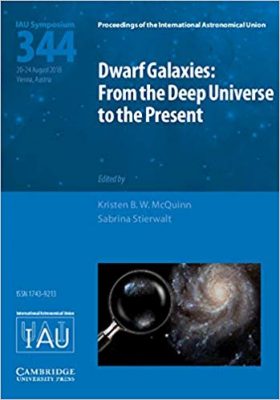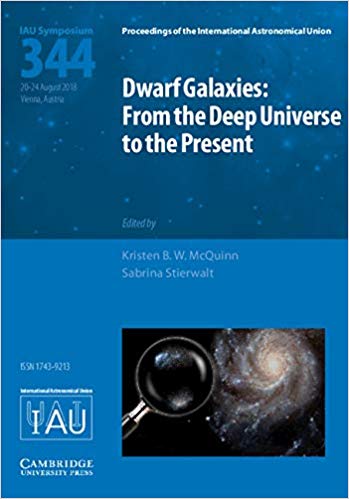 This book is based on the August 20-24, 2018 proceedings of the IAU in Vienna Austria
This book is based on the August 20-24, 2018 proceedings of the IAU in Vienna Austria
Editors: Kristen B.W. McQuinn and Sabrina Stierwalt
Publisher: Cambridge University Press – 506 pages
Book Review by: Sonu Chandiram
What are dwarf galaxies?
They are low-mass systems that allow us to understand the structure, formation and evolution of galaxies across cosmic time, particularly the stellar, chemical, and dynamical properties of star systems in nearby galaxies. They provide a unique window into the complex physics of the early universe.
The proceedings of this IAU Symposium gave us a lot, such as a clearer understanding of:
- Local Group dwarf galaxies
- The interstellar medium and star formation in dwarf galaxies
- Metallicity, massive stars, and chemical evolution
- The dwarf galaxy-environment connection
- Low-mass galaxies at high redshift
- Dwarfs as cosmological probes
The study of dwarf galaxies – by astronomers, physicists, and other scientists, or the sharing and exchange of their findings in meetings such as this symposium – have served to further our understanding of the universe and its components.
The editors write in the Preface: “These dwarf galaxies are now not only seen as analogs to galaxies in the universe, but they have become direct probes of the earliest epochs of star formation. Detailed studies of the cold interstellar medium in nearby galaxies made possible by Herschel and ALMA can now place constraints on the dust and molecular gas content of low mass galaxies.”
ALMA is the Atacama Large Millimeter/sub-millimeter Array. It is a transformative radio telescope that can study cosmic light that straddles the boundary between radio and infrared. Most objects in the Universe emit this kind of energy, so the ability to detect it has been a driver for astronomers for decades.
Astronomers have also been studying low-mass galaxies at high redshift. A redshift is the displacement of spectral lines toward longer wavelengths (the red end of the spectrum) in radiation from distant galaxies and celestial objects. This is interpreted as a Doppler shift that is proportional to the velocity of recession and thus to distance.
There were numerous topics discussed at the aforementioned August 2018 symposium, and they are listed in this book. Too numerous to list them all here, we list some of them below:
The Future of Dwarf Galaxy Research:
- What Telescopes Will Discover
- What Simulations Will Predict
Local Group Dwarf Galaxies:
- The merger debris of dwarf galaxies in the local stellar halo
- Local Group Dwarf Galaxies: A wide angle chemical survey of the Sagittarius dwarf Spheroidal galaxy
Metallicity, Massive Stars and Chemical Evolution:
- Massive star evolution: feedbacks in the low-Z environment
- What do planetary nebulae and H II regions reveal about the chemical evolution of nearby dwarf galaxies?
- Synergies between Massive Stars and Metal-poor Dwarf Irregular Galaxies
- Molecular Composition of Local Dwarf Galaxies: Astrochemistry in Low-metallicty Environments
Interstellar Medium and Star Formation:
- The Interstellar Medium and Star Formation in Dwarf Galaxies
- Dwarf Galaxies: Their Low Metallicity Interstellar Medium
- Stellar Feedback in Dwarf Irregular Galaxies with Radio Continuum Observation
- Star Formation and Molecular Gas in Extremely Metal-poor Galaxies: Insights from the Thermal Balance in Neutral Gas
The Dwarf-Galaxy Environment Connection:
- Evolution of star-forming dwarf galaxies in different environments
- Cosmic Web Research: Where are the Missing Dwarf Galaxies and the Inter-Galactic Clouds
- Mass Distribution in Stellar Structures of Local Dwarfs
- Uncovering Dwarf Elliptical Evolution through Spatially Resolved Spectroscopy
Low Mass Galaxies at High Redshift:
- Dwarf Galaxies: From the Epoch of Peak Star Formation to the Epoch of Re-ionization
- Dwarf Galaxies at Low and High Redshift
Dwarfs as Cosmological Probes:
- Dwarf Galaxies as Cosmological Probes
- Simulations of the Dwarf Scale: From Violent Dwarfs at Cosmic Dawn and Cosmic Noon to Quiet Discs Today
Today, there are not many books out in the market on dwarf galaxies. A search on Amazon showed only 295 titles. This is probably due to the reason that this sector of astronomy is still new. This book is a beginning in the efforts of scientists to fill that void in knowledge.
Editors:
Kristen B.W. McQuinn is affiliated with the University of Texas in Austin, Texas, and with Rutgers University in New Brunswick, New Jersey.
Sabrina Stierwalt is affiliated with the Infrared Processing and Analysis Center (IPAC) at the California Institute of Technology in Pasadena, and with Occidental College in Los Angeles.







